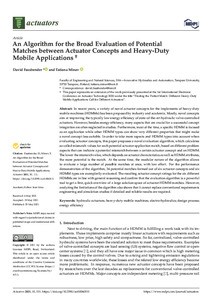An Algorithm for the Broad Evaluation of Potential Matches between Actuator Concepts and Heavy-Duty Mobile Applications
Fassbender, David; Minav, Tatiana (2021-05-25)
Fassbender, David
Minav, Tatiana
25.05.2021
111
Julkaisun pysyvä osoite on
https://urn.fi/URN:NBN:fi:tuni-202105275497
https://urn.fi/URN:NBN:fi:tuni-202105275497
Kuvaus
Peer reviewed
Tiivistelmä
In recent years, a variety of novel actuator concepts for the implements of heavy-duty mobile machines (HDMMs) has been proposed by industry and academia. Mostly, novel concepts aim at improving the typically low energy efficiency of state-of-the-art hydraulic valve-controlled actuators. However, besides energy-efficiency, many aspects that are crucial for a successful concept integration are often neglected in studies. Furthermore, most of the time, a specific HDMM is focused as an application while other HDMM types can show very different properties that might make a novel concept less suitable. In order to take more aspects and HDMM types into account when evaluating actuator concepts, this paper proposes a novel evaluation algorithm, which calculates so-called mismatch values for each potential actuator-application match, based on different problem aspects that can indicate a potential mismatch between a certain actuator concept and an HDMM. The lower the mismatch value, which depends on actuator characteristics as well as HDMM attributes, the more potential is the match. At the same time, the modular nature of the algorithm allows to evaluate a large number of possible matches at once, with low effort. For the performance demonstration of the algorithm, 36 potential matches formed out of six actuator concepts and six HDMM types are exemplarily evaluated. The resulting actuator concept ratings for the six different HDMMs are in line with general reasoning and confirm that the evaluation algorithm is a powerful tool to get a first, quick overview of a large solution space of actuator-HDMM matches. However, analyzing the limitations of the algorithm also shows that it cannot replace conventional requirements engineering and simulation studies if detailed and reliable results are required.
Kokoelmat
- TUNICRIS-julkaisut [16983]
